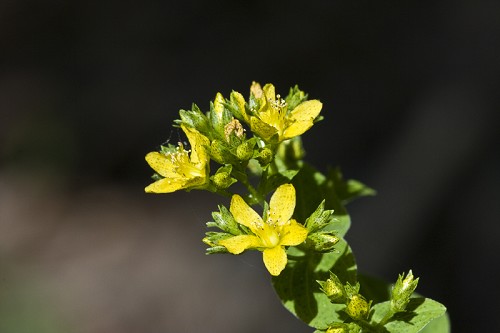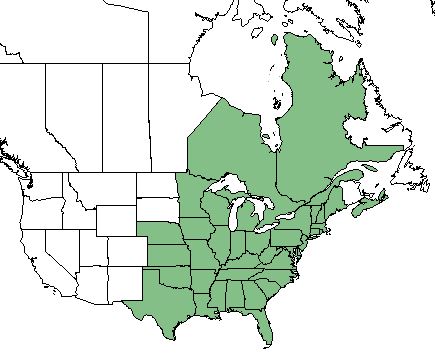Difference between revisions of "Hypericum punctatum"
(→Ecology) |
|||
| Line 31: | Line 31: | ||
===Habitat=== <!--Natural communities, human disturbed habitats, topography, hydrology, soils, light, fire regime requirements for removal of competition, etc.--> | ===Habitat=== <!--Natural communities, human disturbed habitats, topography, hydrology, soils, light, fire regime requirements for removal of competition, etc.--> | ||
''H. punctatum'' has a low tolerance for drought. It is tolerant of shade. <ref name= "USDA"> [https://plants.usda.gov/core/profile?symbol=CEAM USDA Plant Database]</ref> | ''H. punctatum'' has a low tolerance for drought. It is tolerant of shade. <ref name= "USDA"> [https://plants.usda.gov/core/profile?symbol=CEAM USDA Plant Database]</ref> | ||
| − | It is commonly found in fields and woodland borders.<ref name= "Weakley"> Weakley, A. S. (2015). Flora of the Southern and Mid-Atlantic States. Chapel Hill, NC, University of North Carolina Herbarium.</ref> This species also prefers partial shade, and has a low tolerance for calcium carbonate.<ref name= "lady bird">[[https://www.wildflower.org/plants/search.php?search_field=&newsearch=true]] Lady Bird Johnson Wildflower Center. Accessed: May 28, 2019</ref> Specimens of ''H. punctatum'' have been collected from upland pinelands that are annually burned, and other similar sandhill habitats that are well-drained.<ref name= "herbarium">Florida State University Robert K. Godfrey Herbarium database. URL: http://herbarium.bio.fsu.edu. Last accessed: May 2019. Collectors: Wilson Baker, Robert K. Godfrey, Jeffrey M. Kane, Roy Komarek, and R. A. Norris. States and Counties: Florida: Leon. Georgia: Thomas.</ref> | + | It is commonly found in fields and woodland borders.<ref name= "Weakley"> Weakley, A. S. (2015). Flora of the Southern and Mid-Atlantic States. Chapel Hill, NC, University of North Carolina Herbarium.</ref> This species also prefers partial shade, and has a low tolerance for calcium carbonate.<ref name= "lady bird">[[https://www.wildflower.org/plants/search.php?search_field=&newsearch=true]] Lady Bird Johnson Wildflower Center. Accessed: May 28, 2019</ref> Specimens of ''H. punctatum'' have been collected from upland pinelands that are annually burned, and other similar sandhill habitats that are well-drained.<ref name= "herbarium">Florida State University Robert K. Godfrey Herbarium database. URL: http://herbarium.bio.fsu.edu. Last accessed: May 2019. Collectors: Wilson Baker, Robert K. Godfrey, Jeffrey M. Kane, Roy Komarek, and R. A. Norris. States and Counties: Florida: Leon. Georgia: Thomas.</ref> It has also been recorded in outcrop oak hickory forests.<ref>Bostick, P. E. (1971). "Vascular Plants of Panola Mountian, Georgia " Castanea 46(3): 194-209.</ref> |
===Phenology=== <!--Timing off flowering, fruiting, seed dispersal, and environmental triggers. Cite PanFlora website if appropriate: http://www.gilnelson.com/PanFlora/ --> | ===Phenology=== <!--Timing off flowering, fruiting, seed dispersal, and environmental triggers. Cite PanFlora website if appropriate: http://www.gilnelson.com/PanFlora/ --> | ||
Revision as of 20:09, 28 May 2019
spotted St. John's-wort [1]
| Hypericum punctatum | |
|---|---|

| |
| Photo by the Southeastern Flora Plant Database | |
| Scientific classification | |
| Kingdom: | Plantae |
| Division: | Magnoliophyta - Flowering plants |
| Class: | Magnoliopsida - Dicots |
| Order: | Theales |
| Family: | Clusiaceae |
| Genus: | Hypericum |
| Species: | H. punctatum |
| Binomial name | |
| Hypericum punctatum Lam. | |

| |
| Natural range of Hypericum punctatum from USDA NRCS Plants Database. | |
Contents
Taxonomic Notes
Synonyms: Hypericum punctatum Lamarck var. punctatum; Hypericum subpetiolatum E.P. Bicknell ex Small
Description
H. punctatum is a perennial forb/herb of the Clusiaceae family native to North America. [1]
Distribution
H. punctatum is found throughout the eastern United States and up into Eastern Canada, specifically Ontario and Quebec. [1]
Ecology
Habitat
H. punctatum has a low tolerance for drought. It is tolerant of shade. [1] It is commonly found in fields and woodland borders.[2] This species also prefers partial shade, and has a low tolerance for calcium carbonate.[3] Specimens of H. punctatum have been collected from upland pinelands that are annually burned, and other similar sandhill habitats that are well-drained.[4] It has also been recorded in outcrop oak hickory forests.[5]
Phenology
Flowers bloom in the early summer months.[1] It commonly flowers between June and September.[2]
Seed dispersal
This species is thought to be dispersed by gravity. [6]
Fire ecology
H. punctatum is not a fire resistant forb but has a mild tolerance to fire. [1]
Pollination
This species is considered by pollination ecologists to be of special value to bumble bees since the flowers attract such large numbers for pollination.[3]
Use by animals
It has been recorded to be eaten by white-tailed deer.[7]
Conservation and Management
It is considered vulnerable in the Canadian province Quebec, critically imperiled in Nebraska, and an exotic species in the Canadian province Newfoundland.[8]
Cultivation and restoration
Photo Gallery
References and notes
- ↑ 1.0 1.1 1.2 1.3 1.4 1.5 USDA Plant Database
- ↑ 2.0 2.1 Weakley, A. S. (2015). Flora of the Southern and Mid-Atlantic States. Chapel Hill, NC, University of North Carolina Herbarium.
- ↑ 3.0 3.1 [[1]] Lady Bird Johnson Wildflower Center. Accessed: May 28, 2019
- ↑ Florida State University Robert K. Godfrey Herbarium database. URL: http://herbarium.bio.fsu.edu. Last accessed: May 2019. Collectors: Wilson Baker, Robert K. Godfrey, Jeffrey M. Kane, Roy Komarek, and R. A. Norris. States and Counties: Florida: Leon. Georgia: Thomas.
- ↑ Bostick, P. E. (1971). "Vascular Plants of Panola Mountian, Georgia " Castanea 46(3): 194-209.
- ↑ Kirkman, L. Katherine. Unpublished database of seed dispersal mode of plants found in Coastal Plain longleaf pine-grasslands of the Jones Ecological Research Center, Georgia.
- ↑ Atwood, E. L. (1941). "White-tailed deer foods of the United States." The Journal of Wildlife Management 5(3): 314-332.
- ↑ [[2]] NatureServe Explorer. Accessed: May 28, 2019